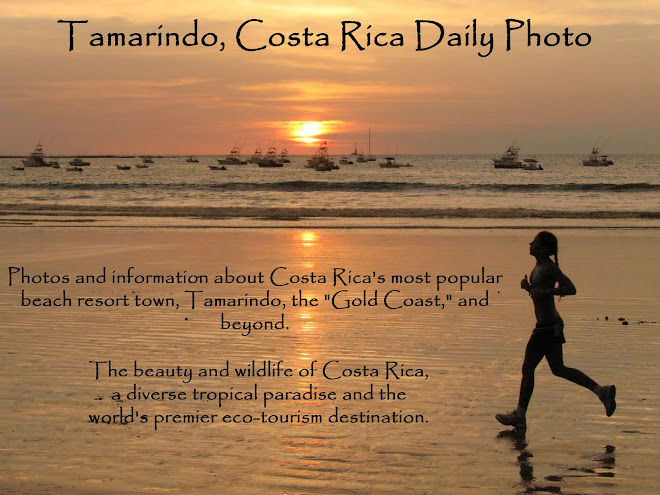+P1090872.jpg)
Our airliner flew right over the Papagayo peninsula on one of our flights to Liberia from the USA. In this photo, you can see the golf course in the wide part of the peninsula and the hotel complex at the narrow neck of the peninsula.
If you click and enlarge the photo, you should be able to see the hotel lobby and spa that are located in the semi-circular building. The swimming pool is right behind the lobby building, and hotel rooms are in the long buildings that run parallel to the beach. The hotel bungalow units and private villa residences are sprinkled on the hillsides.
This photo shows how the hotel has access to small beaches on both the ocean (left) and gulf (right) sides of the peninsula. It also shows that the beaches do not extend around the peninsula, but are small beaches in coves of the otherwise rocky coast.
My feelings about Papagayo as an experience for tourists is that it provides a beautiful environment, luxurious amenities, superb service, but is somewhat isolated from the real Costa Rica. It is its own private world. If a visitor is interested in a destination resort and wants outstanding facilities for golf, tennis, spa, swimming, lounging, dining, etc., it is perfect. But as a destination resort, it is like a little of Hawaii transplanted to Costa Rica.
If guests do not want to limit themselves to the pristine but somewhat artificial world of the Papagayo peninsula, there are wonderful opportunities to enjoy some of the real Costa Rica outside the gates of the peninsula. There are opportunities to take local excursions to view wildlife, waterfalls, zip lines, sailing, hiking, and many of the other activities that so many people enjoy. I have seen howler monkeys and iguanas right along the road within the Papagayo resort, so some of the real Costa Rica is present at the resort.
In sum, the Papagayo resort offers a choice of either isolated luxury, or a very comfortable base from which to explore the wonder of one of the most diverse ecosystems on the planet within a short drive of the resort's gates, or a combination of both experiences.
For visitors who are interested in second homes and vacation condos in Costa Rica, I will share a few thoughts as well. Again, different people have different tastes. Some people like the master-planned communities such as Papagayo or Hacienda Pinilla because everything is under the control of the developer, all the landscaping is the coordinated, etc.
My wife and I decided that we would prefer to have our condos in Tamarindo and Langosta, however, because we wanted to be in a town where we could walk to any of 50 restaurants, walk along the beach for miles, and feel part of a community that has some diversity, even if it is mostly international rather than local residents. My wife and I felt that if we had our condos in a master-planned community, we would tend not to leave the development and would feel limited to and grow tired of resort restaurants. My wife is a "foodie" and we would much rather have a wide choice of different restaurants to walk to in the evening.
Both of our condos are in buildings that have gated entrances and 24 hour security, so that reason to select a master-planned community was mitigated. We feel quite safe walking around Tamarindo and Langosta.
 Here is the set up for the annual New Year's Eve party at the Tamarindo Diria Resort. All of the hotel guests are seated at tables around the large swimming pool, followed by a concert at an amphitheater that is next to the pool.
Here is the set up for the annual New Year's Eve party at the Tamarindo Diria Resort. All of the hotel guests are seated at tables around the large swimming pool, followed by a concert at an amphitheater that is next to the pool.











+0512+P1000729.jpg)
++0514+P1000731.jpg)
++0511+P1000727.jpg)
+P1090872.jpg)
+P1090876.jpg)














+0366+P1000466.jpg)


.JPG)

